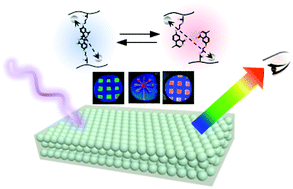Photo-responsive photonic hydrogel: in situ manipulation and monitoring of cell scaffold stiffness†
Abstract
Building scaffolds with heterogeneous and reconfigurable mechanical properties has been recognized as the key to recapitulating the natural extracellular microenvironments for in vitro cell incubation systems. However, in situ changing and tracking of the mechanical change of cell scaffolds are still challenging. In this paper we developed a novel strategy to solve this problem. We show a convenient method for tracking the hardness of cell scaffolds in a non-invasive manner via their color change. This is achieved by introducing colloidal crystal features into a photo-reconfigurable hydrogel, which leads to a smart hydrogel scaffold with dynamically adjustable and in situ monitorable mechanical properties. The stiffness of the hydrogel can be spatiotemporally and dynamically manipulated by light; meanwhile, its changes can be in situ recognized by analyzing the hydrogel color. This allows real-time control and investigation of the extracellular stiffness in cell incubation systems in a non-invasive fashion. In addition, the cell–matrix interactions on this smart scaffold can be easily understood owing to the simultaneous observation of cell morphology and matrix stiffness under a microscope. We also show that such a hydrogel could be used as a user-designable microarray for cell culture applications.



 Please wait while we load your content...
Please wait while we load your content...